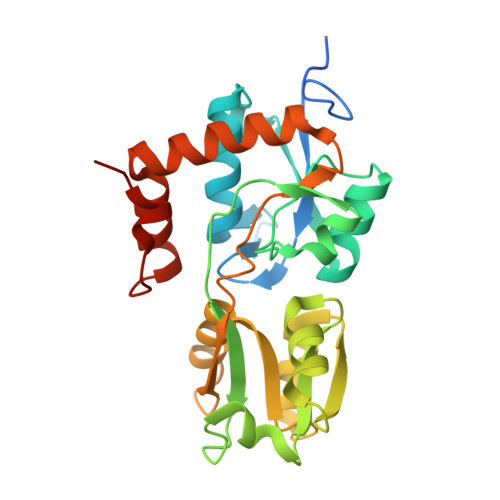Structural Basis for High Specificity of Amadori Compound and Mannopine Opine Binding in Bacterial Pathogens.
Marty, L., Vigouroux, A., Aumont-Nicaise, M., Dessaux, Y., Faure, D., Morera, S.(2016) J Biol Chem 291: 22638-22649
- PubMed: 27609514
- DOI: https://doi.org/10.1074/jbc.M116.745562
- Primary Citation of Related Structures:
5L9G, 5L9I, 5L9L, 5L9O, 5L9P, 5L9S, 5LOM, 6HQH - PubMed Abstract:
Agrobacterium tumefaciens pathogens genetically modify their host plants to drive the synthesis of opines in plant tumors. Opines are either sugar phosphodiesters or the products of condensed amino acids with ketoacids or sugars. They are Agrobacterium nutrients and imported into the bacterial cell via periplasmic-binding proteins (PBPs) and ABC-transporters. Mannopine, an opine from the mannityl-opine family, is synthesized from an intermediate named deoxy-fructosyl-glutamine (DFG), which is also an opine and abundant Amadori compound (a name used for any derivative of aminodeoxysugars) present in decaying plant materials. The PBP MotA is responsible for mannopine import in mannopine-assimilating agrobacteria. In the nopaline-opine type agrobacteria strain, SocA protein was proposed as a putative mannopine binding PBP, and AttC protein was annotated as a mannopine binding-like PBP. Structural data on mannityl-opine-PBP complexes is currently lacking. By combining affinity data with analysis of seven x-ray structures at high resolution, we investigated the molecular basis of MotA, SocA, and AttC interactions with mannopine and its DFG precursor. Our work demonstrates that AttC is not a mannopine-binding protein and reveals a specific binding pocket for DFG in SocA with an affinity in nanomolar range. Hence, mannopine would not be imported into nopaline-type agrobacteria strains. In contrast, MotA binds both mannopine and DFG. We thus defined one mannopine and two DFG binding signatures. Unlike mannopine-PBPs, selective DFG-PBPs are present in a wide diversity of bacteria, including Actinobacteria, α-,β-, and γ-proteobacteria, revealing a common role of this Amadori compound in pathogenic, symbiotic, and opportunistic bacteria.
Organizational Affiliation:
From the Institute for Integrative Biology of the Cell (I2BC), CNRS CEA Université Paris-Sud, Université Paris-Saclay, Avenue de la Terrasse, Gif-sur-Yvette 91198, France.
















